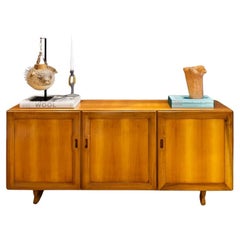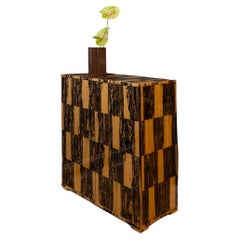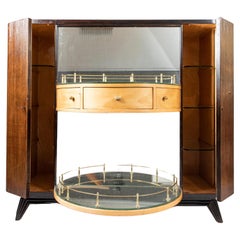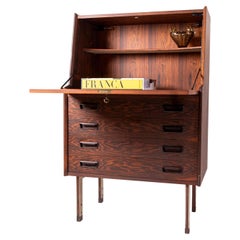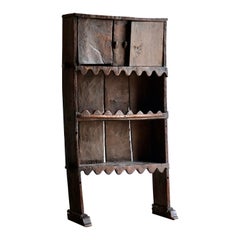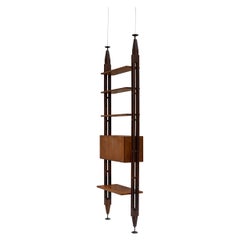CAVALIERE GALLERY Case Pieces and Storage Cabinets
to
Height
to
Width
to
Depth
to
4
3
1
3
3
1
3
1
1
1
4
3
1
1
1
4
3
1
1
4
3
3
1
1
1
Rare Franco Albini cabinet by Poggi model Mb15
By Franco Albini
Located in Milano, MI
Rare Franco Albini cabinet, production by Poggi Italy 1950 mod. Mb15 in walnut wood.
Category
Vintage 1950s Italian Mid-Century Modern Cabinets
Materials
Nutwood
Albino Wood Cabinet with two internal shelves in maple wood.
Located in Milano, MI
Exclusive and very elegant Zebra Albino Cabinet with two internal shelves in maple wood.
Category
Early 2000s Italian Cabinets
Materials
Maple, Zebra Wood
Rotating Cabinet , unique piece with the Expertise of Fondazione Borsani Archive
By Osvaldo Borsani
Located in Milano, MI
Osvaldo Borsani Rotating Cabinet bar , unique piece with the Expertise of Fondazione Borsani Archive
In walnut, mirror glass, brass and parchment
Category
Vintage 1940s Italian Mid-Century Modern Dry Bars
Materials
Brass
Secretaire in Palisander Wood by Arne Wahl Iversen for Vinde Mobelfabrik
By Arne Wahl Iversen
Located in Milano, MI
This secretaire in palisander wood by Arne Wahl Iversen for Vinde Mobelfabrik is a great piece to be placed in a chic and refin...
Category
Vintage 1960s Danish Mid-Century Modern Secretaires
Materials
Palisander
Related Items
Unique Antique 19th Century Wood Folk Cabinet / Shelves, France
Located in LEWES, GB
Stunning rustic / folk French Pyranees 19th century wooden cabinet / shelf unit. Scalloped carved shelves and two door cabinet. Wonky but sturdy and ready to use. One of a kind....
Category
Antique Late 19th Century French Folk Art Cabinets
Materials
Wood
$6,787
H 57.88 in W 31.11 in D 10.24 in
Midcentury LB7 modular bookcase designed by Franco Albini for Poggi, Italy 1957
By Poggi, Franco Albini
Located in Piacenza, Italy
Modular bookcase model LB7 designed by Franco Albini for Poggi.
Marked Poggi Pavia.
An extremely flexible bookcase, with different modular options, suited to being against a wall or...
Category
Vintage 1950s Italian Mid-Century Modern Bookcases
Materials
Wood
$10,630
H 118.12 in W 35.44 in D 15.75 in
Vintage Danish Teak Six-Drawer Dresser by Arne Wahl Iversen
By Arne Wahl Iversen, Vinde Møbelfabrik
Located in San Jose, CA
Mid Century Modern lowboy dresser in teak designed by Arne Wahl Iversen for Vinde Møbelfabrik, circa 1960's. This piece offers plenty of storage including six dovetailed drawers with...
Category
Vintage 1960s Danish Scandinavian Modern Dressers
Materials
Teak
Mid Century Danish Modern Wall Unit with Shelves & Cabinets with Desk in Teak
Located in Philadelphia, PA
A large Scandinavian wall unit circa 1960's. It features teak wood finish with a drop down center desk. The unit is totally modular and can arra...
Category
Vintage 1960s Danish Scandinavian Modern Shelves
Materials
Teak
$4,800
H 72 in W 82 in D 16.5 in
French Two Piece Blue Hand-Painted Cabinet Hutch with Shelves
Located in Haddonfield, NJ
Hand Painted 2 Piece French style Cabinet or Hutch. This tall hand-painted piece would make a fabulous statement in a living room, dining room or kitchen. Not a detail has been misse...
Category
21st Century and Contemporary European French Provincial Cabinets
Materials
Wood, Paint
Lb7 bookcase, designed by Franco Albini for Poggi Pavia, Italy
By Franco Albini, Poggi
Located in Piacenza, Italy
Modular bookshelf designed by Franco Albini in 1956 for Poggi Pavia.
An exceptionally flexible bookshelf with various modular options, suitable to be placed against a wall or used as...
Category
Vintage 1950s Italian Mid-Century Modern Bookcases
Materials
Wood
$31,891
H 111.82 in W 102.37 in D 13.78 in
Arne Wahl Iversen Planter, Scandinavian Design, 1960s
By Arne Wahl Iversen
Located in Ternay, Auvergne-Rhône-Alpes
Planter made of teak by Arne Wahl Iversen
Minor damage on the top (see photos).
Category
Vintage 1960s Danish Scandinavian Modern Planters and Jardinieres
Materials
Teak
Industrial Cabinet with Shelves & Glass Door
Located in Brooklyn, NY
This tall display cabinet has been taken down to bare metal and then sealed to give a handsome industrial factory look. The unit comes from a doctors office and is at least 100 years...
Category
Mid-20th Century Industrial Cabinets
Materials
Metal
Important Cabinet with Two Body in Blackened Wood Carved and Engraved
Located in Saint-Ouen, FR
IMPORTANT CABINET WITH TWO BODY IN BLACKENED WOOD CARVED AND ENGRAVED
ORIGIN: FRANCE
PERIOD: 17TH CENTURY
Height: 188 cm
Width: 135 cm
Depth: 53.5 cm
Blackened wood and veneer: rosewood, ebony, pear, mahogany
Framed in oak wood
A real ceremonial piece of furniture, this two-part cabinet opens with two historiated panels and two drawers in the upper part and two leaves and two belt drawers in the lower part.
Richly worked, it offers both inside and outside a floral decoration, finely engraved which contrasts with the importance given to geometric lines. This duality, typical of this type of cabinet, confirms its dating and its origin.
In addition, the gilded metal locks and fittings enhance the sumptuous trait of this piece of furniture and also contribute to its ornamentation.
Furniture of predilection for “enclosing the most precious things” (Furetière, Dictionnaire, 1690) the appearance of cabinets in the 16th century accompanied the development of wunderkammern, these cabinets of curiosities enriched both by the vogue for the antique and by distant expeditions which bring back with them natural wonders and rare testimonies of distant civilisations. The curious, combining fortune and culture, brings together antique medals, rare plants, fossils, or oriental ornaments. This meeting of pieces which embodies much more than their material reality, a subjective evocation of all the riches of the earth and all the knowledge of men, acts in the eyes of its owner like a microcosm of which he is the master and which he enjoys according to his will.
This is how the first cabinets were designed to be transportable, often wooden structures calling for riches only those they housed for a collector who refused to part with them, even temporarily.
In the 17th century, the cabinet gained in technical complexity and luxurious materials until it could no longer be moved itself and became a prized and expensive collector’s item...
Category
Antique 17th Century Cabinets
Materials
Ebony, Mahogany, Pearwood, Rosewood
$27,167
H 136 in W 135 in D 53.5 in
Mid Century Danish Modern Teak make up Vanity jewelry box by Arne Wahl Iversen
By Vinde Møbelfabrik, Arne Wahl Iversen
Located in Brooklyn, NY
Mid century Danish Modern teak make up vanity or desk. Beautiful light teak color with a nice grain. Flip top mirror with brass ring pull opens to a sliding felt lined jewelry box wi...
Category
Vintage 1960s Danish Mid-Century Modern Desks
Materials
Felt, Mirror, Teak
$1,800 Sale Price
20% Off
H 30 in W 32 in D 18 in
Italian Mid-Century Chinoiserie Cocktail Bar Set Attr. to Osvaldo Borsani
By Osvaldo Borsani
Located in Rome, IT
Striking Italian Design Chinoiserie painted wood Cocktail bar set .
The cocktail bar includes a counter element and illuminated cabinet, with burl birch wood sides and brass detail...
Category
Mid-20th Century Italian Mid-Century Modern Dry Bars
Materials
Wood
$13,229 Sale Price
20% Off
H 83.86 in W 53.94 in D 53.94 in
Franco Albini Rosewood Mid-Century Modern “LB7” Modular Bookcase for Poggi, 1957
By Franco Albini, Poggi
Located in Vicenza, IT
LB7 bookcase, designed by Franco Albini and manufactured by Poggi in 1957.
Modular bookstore composed by upholds, containers with flying and doors, shelve. The industrial standard for every product component allows permanent and different solutions, from the bearing structures to the elements. The structure does not need anchorages to the wall and can be placed in the middle of the space.
This set is composed of 3 modules, ten shelves, and three containers.
It is made of Rosewood, iron, and brass.
Excellent vintage condition.
Franco Albini was born in Robbiate in 1905, and after his childhood and part of his youth, he moved to Milan.
He graduated at Politecnico of Milan, Faculty of Architecture, in 1929, and He collaborated for three years in Giò Ponti and Emilio Lancia’s office. He probably had his international contacts here, at The International Exposition of 1929 in Barcelona and Paris, where he visited le Corbusier’s office, as Franca Helg used to tell.
Throughout these first three years, his works were undoubtedly related to XIXth Century. His meeting with Edoardo Persico marks an evident turnover towards rationalism and writers for “Casabella” magazine. Persico’s thoughtful and ironical comments on some of Albini’s drawings for office furniture caused him deep upsetting. “I spent days of real anxiety – tells Albini – I had to answer all questions. I had a long fever”.
The new phase that the meeting provoked begins with opening his own first office at Via Panizza with Renato Camus and Giancarlo Palanti. The group of Architects starts taking care of social housing, participating in the competition for the Baracca neighborhood in 1932, and then realizing the Ifacp neighborhood: Fabio Filzi (1936/38), Gabriele D’Annunzio, and Ettore Ponti (1939).
During those years, He also worked for his first private villa (Pestarini).
It is mainly in the context of exhibitions that the Italian architect experiments the compromise between rigor and poetic fantasy that Pagano was talking about; He conceived all the elements that would become recurrent in all types of his work – Architecture, Interiors, Design. The 1933 opening of the new Triennale of Milano, in Palazzo dell’Arte, becomes an occasion to express the highly innovative character of rationalist thinking. In this place, to experiment with new materials and solutions, but most of all a “method”.
Young rationalist architects cultivated the art of exhibiting as a communication lab, an open field to space solutions.
Albini, with Giancarlo Palanti, sets the steel structure house (with R. Camus, G. Mazzoleni, G. Minoletti and coordination by G. Pagano) designing also its furniture. For the next Triennale in 1936, marked by Persico’s early death, Franco Albini, together with a group of young architects around Pagano, takes care of the exhibition of Dwelling, where he presented 3 types of lodgings.
In the same year, Albini and Romano design the exhibition for Ancient Italian jewelry: vertical uprights, simple linear poles design space. This element is recurring in other works, like the Scipione exhibition (1941), Vanzetti stand (1942), and Olivetti shop in Paris (1956). The architectural space is readable through a grid, introducing a third dimension, the vertical one, with a sense of lightness and transparency.
Upright is also used in design objects, such as the Veliero bookcase...
Category
Vintage 1950s Italian Mid-Century Modern Shelves
Materials
Brass, Iron
$31,891
H 109.45 in W 104.34 in D 13.78 in
